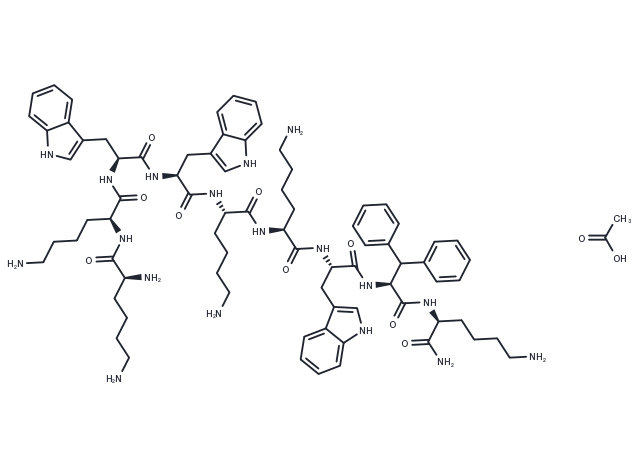store at low temperature,keep away from moisture
Powder: -20°C for 3 years | In solvent: -80°C for 1 year

LTX315 acetate (Oncopore acetate) is an oncolytic peptide with potent anticancer activity, with IC50 values of 34.3 µM for MRC-5, 8.3 µM for A20, and 11 µM for AT84, respectively.

| Pack Size | Availability | Price/USD | Quantity |
|---|---|---|---|
| 1 mg | In stock | $ 68.00 | |
| 2 mg | In stock | $ 97.00 | |
| 5 mg | In stock | $ 139.00 | |
| 10 mg | In stock | $ 239.00 | |
| 25 mg | In stock | $ 467.00 | |
| 50 mg | In stock | $ 685.00 | |
| 100 mg | In stock | $ 975.00 |


| Description | LTX315 acetate (Oncopore acetate) is an oncolytic peptide with potent anticancer activity, with IC50 values of 34.3 µM for MRC-5, 8.3 µM for A20, and 11 µM for AT84, respectively. |
| Targets&IC50 | A20:8.3 µM, AT84:11 µM, MRC5:34.3 µM |
| In vitro | LTX315 acetate induces rapid killing of cancer cells. LTX315 acetate is equally potent against drug-resistant cancer cells, non-toxic to erythrocytes, shows high plasma protein binding, and can be rapidly degraded to non-toxic metabolites. The oncolytic activity of LTX315 acetate results from direct lysis of the plasma membrane and permeabilization of the mitochondrial membrane, resulting in cell death due to necrosis and release of tumor antigens. Treatment of cancer cells with LTX315 acetate results in the release of several danger signals (DAMPs) that are associated with immunogenic cell death and stimulation of adaptive immune responses[1]. |
| In vivo | Intratumoral administration of LTX315 acetate resulted in tumor necrosis and immune cell infiltration into the tumor parenchyma, followed by complete tumor regression in most animals. LTX-315 induces the release of risk-associated molecular patterning molecules, such as high mobility group box-1 proteins, in vitro, followed by upregulation of pro-inflammatory cytokines such as interleukin (IL) 1β, IL6, and IL18 in vivo. Animals cured by LTX315 acetate treatment were protected from rechallenging with live intradermal and intravenous B16 tumor cells [2]. |
| Synonyms | KKWWKKW-Dip-K-NH2 acetate, Oncopore acetate, Ruxotemitide acetate, LTX315 acetate(1345407-05-7, Free base) |
| Molecular Weight | 1499.84 |
| Formula | C80H110N18O11 |
store at low temperature,keep away from moisture
Powder: -20°C for 3 years | In solvent: -80°C for 1 year
You can also refer to dose conversion for different animals. More
bottom
Please see Inhibitor Handling Instructions for more frequently ask questions. Topics include: how to prepare stock solutions, how to store products, and cautions on cell-based assays & animal experiments, etc.
LTX315 acetate Others Ruxotemitide Acetate LTX-315 acetate KKWWKKW-Dip-K-NH2 acetate Oncopore acetate LTX-315 Acetate Ruxotemitide acetate LTX315 acetate(1345407-05-7, Free base) LTX 315 Acetate KKWWKKW-Dip-K-NH2 Acetate Oncopore Acetate LTX315 Acetate inhibitor inhibit
